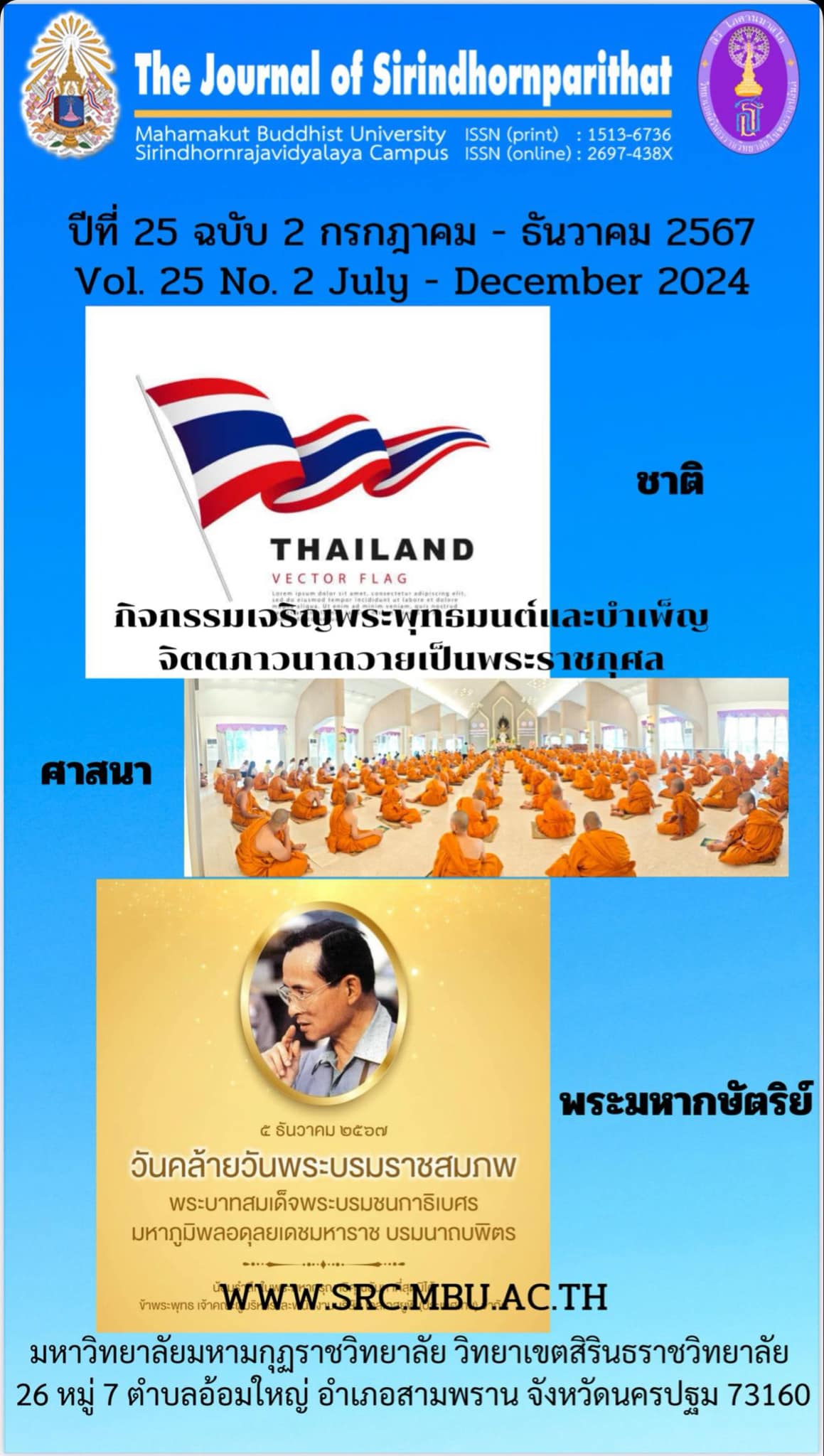Model Of The Exercising Power Of The School Administrators Hold The Position For The First Time Affect The Subordinate Of Compliance In Primary School
Keywords:
Power of the school administrator hold the position for the first time, Subordinate of complianceAbstract
The purpose of this research were to 1) synthesize the variables of the exercise of power of the school administrator, 2) explore factor of the subordinate’s compliance in primary schools, 3) investigate the exercise of power of the school administrator hold the position for the first time affect the subordinates' compliance in primary schools. 4) determine the model of exercise of power by school administrators who hold the first position that affect the subordinates' compliance in primary schools.
The samples used in this research are: There were 248 schools held by the Director of Schools as of 2021, 2 school informants, comprising the incumbent school administrators. 2021 and 1 teacher, totaling 496 students, which was obtained using stratified randomization. The instruments used to collect the data are 5-level estimative questionnaires with a confidence value of 0.98, variable confirmation, stand-up, and pattern confirmation. Exploratory analysis Multiple regression analysis and qualitative data analysis was using content analysis.
The research results indicated that:
1.Variables of exercising of power of the school executive consist of 8 aspects, namely, positional powers; Information power, enforcement power, expert power, reference power, legal authority, individual power, and reward power. 2. Factor of subordinate’s compliance in primary schools There are 8 factors, namely, subordinate performance, Joint performance under executive order, Friendly subordinate assistance, Executive rule compliance, Compliance with subordinate rules, policy formulation executive goals, motivation to support performance. and effective communication. 3. Exercising of power of the school administrator hold the position for the first time affect the subordinates' compliance in primary schools. The coercive power (X3), the information powers (X6), the reference powers (X4), and the reward powers (X2) affect the subordinate's surrender in elementary schools. Together, 52.2 percent predicted the surrender of subordinates in elementary schools, statistically significant at .01.
4. The are six essential components, namely 1) model name 2) principle and emphasis 3) objective of the model of exercising of power of the school administrator hold the position for the first time affect the subordinates' compliance in primary schools 4) four model elements with are coercive power, information power, reference powers, reward powers 5) diagram of the model and its use 6) benefits. The results of the assessment of the model of exercising of power of the school administrator hold the position for the first time affect the subordinates' compliance in primary schools was found that the suitability was at high level and a possibility was at a high level.
References
สิริภา ไชยนุ้ย. (2553). การใช้อำนาจของผู้บริหารสถานศึกษามือใหม่ที่ส่งผลต่อขวัญในการปฏิบัติงานของครูใน 3 จังหวัดชายแดนภาคใต้. สารนิพนธ์ศึกษาศาสตร์มหาบัณฑิต สาขาบริหารการศึกษา มหาวิทยาลัยสงขลานครินทร์.
วันชัย มีชาติ. (2552). การบริหารองค์การ .กรุงเทพฯ: สำนักพิมพ์จุฬาลงกรณ์.
พิพัฒน์ นนทนาธรณ์. (2556). ภาวะผู้นำเชิงปฏิบัติการ:Life Model Operational Leadership: Life Model. กรุงเทพฯ: วิสต้า อินเตอร์ปริ้นท์.
กนกพร พิริยวุฒิกรอุดม. (2558). การส่งเสริมการยอมปฏิบัติตามในองค์กรทางการศึกษา. (ปริญญาปรัชญาดุษฎีบัณฑิต) สาขาวิชาการบริหารการศึกษา บัณฑิตวิทยาลัย มหาวิทยาลัยศิลปากร.
Acosta, M. (2020). An examination of the relationship between power and leadership among educators. Texas: Our Lady of the Lake University San Antonio.
Anter, A. (2014). Max Weber’s Theory of the Modern State. London: Palgrave Macmillan.
Ayanna, M. (2020). Principle of Human Resource Development. Cambridge, M.A.: Perseus.
Bendix, R. (1988). Work and Authority in Industry: Managerial Ideologies in the Course of Industrialization. [n.d.]
Barnard Chester. (1938). General and social system. New Brunswick, N.J. Ruger University press.
Dowse, R. E., & Hughes, J. A. (1972). Political Sociology. Toronto: John Wiley & Sons.
Dudley, C. (2000). Effective Leadership. Texas: Gulf Publishing Company.
Etzioni, A. (1975). A comparative analysis of Complex organizations. New York: Free Press.
Fayol, H. (1949). General and Industrial Management. London: Sir Issac Pitman & Sons.
George, J. M., & Jones, G.R. (2006). Contemporary Management. New York: McGraw-Hill/Irwin.
Graham, R. M. (2015). Human Resource Management. (9thed.). Upper Saddle River, N.J.: Prentice Hall.
Griffin, W., & Moorhead, G. (2006). Organizational Behavior: Managing People and Organizations (8thed.). New York: Houghton Mifflin Company.
Guishan, S. (2001). Management Principle and Practices. [n.d.]
Hersey, P. (2013). Management of organizational behavior. New Jersey: Prentice-Hall Ingo Pies.
Henry, J. M. (2017). Human Resource Management. (10thed.). Boston: McGraw-Hill Irwin.
Hill, E.T. (2009). The Blackwell Guide to Kant’s Ethics. Oxford: Black well Publishing Ltd.
James L. (2011). Power of the Presidency. New York: Macmillan Publishing Company.
Kelman, C. H. (1958). Compliance identification and internalization: Three processes of altitude change. journal of conflict R. Solution.
Kemp, J. & other. (2021). Global Midwifery: Principles, Policy, and Practice. Switzerland. The registered company spring nature.
Khan, A. H. (2008). An introduction to Public Administration. Maryland: University Press America.
Koslowski, P. (2011). Corporate Citizenship and New Governance: The Political Role of Corporation. New York: Springer Dordrecht Heidelberg.
Meechart, W. (2019). Management of organization. Bangkok: Chulalongkorn University Printing House.
Nontanaphorn, P. (2013). Life Model Operational Leadership. Bangkok: Vista interprint.
Olmstead, A. J. (2000). Executive Leadership. Texas: Gulf Publishing Company.
Osborne, J. (2008). Best Practices in Quantitative Methods. Sage Publications, Inc.
Prasad, P. (1997). Managing the Organizational Melting Pot: Dilemmas of Workplace Diversity. California: Sage Publications.
Pebody, J. A. (2000). Total Quality in Managing Human Resources. Delray Beach, Fla: St. Lucie Press.
Poper, M. (2012). Fact and Fantasy about Leadership. Cheltenham: Edward Elgar Publishing Limited.
Robert, N. L. (2005). Human Relationship in Organization. Applications and Skill Building.
Skinner, B. F. (1974). About behaviors. New York: Knopf.
Sharp, T. A. (1973). Organizational Behavior. New Jersey: Prentice Hall.
Sylvia, D. (2010). Leadership through the Ages. Long Grove: Waveland Press.
Steers, M. R. & Sanchez-Runde, J. (2013). Management across cultures: Developing Global competencies. New York: Cambridge University.
Robbins, P. S. (1983). Essentials of Organizational Behavior. Englewood Cliffs: Prentice Hall, Inc.
Roger A. Lohmann, A.R. & Lohmann, N. (2002). Social Administration. New York: Columbia University Press.
Yulk, J.H. (2013). The Structure of Sociological Theory. Illinois: Dancy Press.
Downloads
Published
Issue
Section
License
Copyright (c) 2024 Mahamakut Buddhist University

This work is licensed under a Creative Commons Attribution-NonCommercial-NoDerivatives 4.0 International License.
บทความที่ได้รับการตีพิมพ์เป็นลิขสิทธิ์ของ มหาวิทยาลัยมหามกุฏราชวิทยาลัย วิทยาเขตสิรินธรราชวิทยาลัย
ข้อความที่ปรากฏในบทความแต่ละเรื่องในวารสารวิชาการเล่มนี้เป็นความคิดเห็นส่วนตัวของผู้เขียนแต่ละท่านไม่เกี่ยวข้องกับหาวิทยาลัยมหามกุฏราชวิทยาลัย วิทยาเขตสิรินธรราชวิทยาลัย และคณาจารย์ท่านอื่นๆในมหาวิทยาลัยฯ แต่อย่างใด ความรับผิดชอบองค์ประกอบทั้งหมดของบทความแต่ละเรื่องเป็นของผู้เขียนแต่ละท่าน หากมีความผิดพลาดใดๆ ผู้เขียนแต่ละท่านจะรับผิดชอบบทความของตนเองแต่ผู้เดียว



